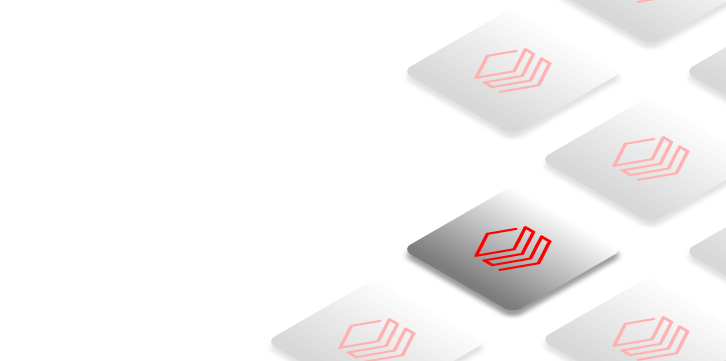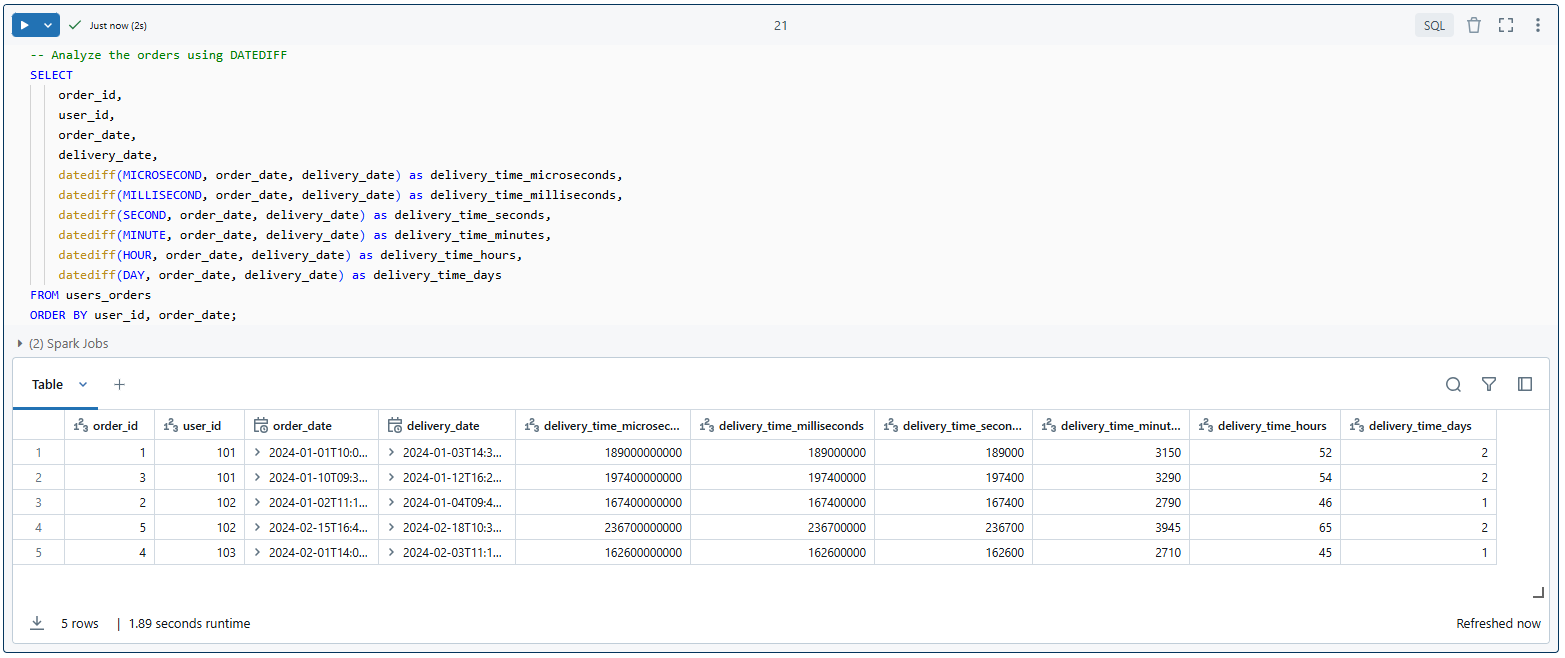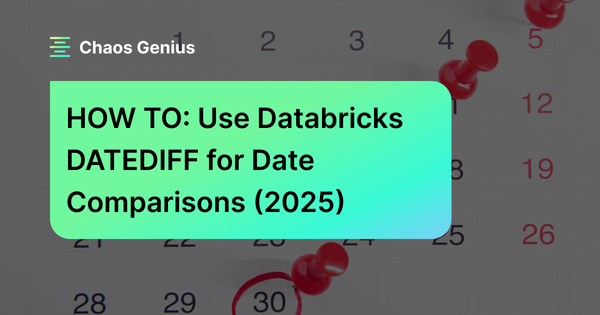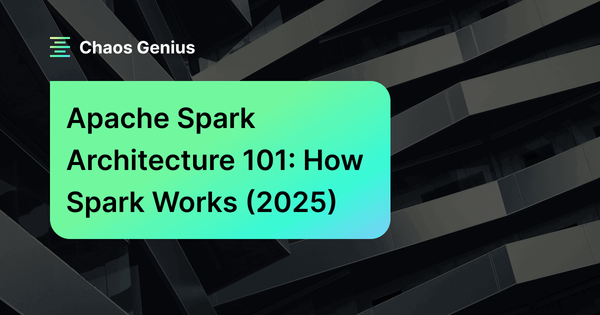Databricks is a powerful unified analytics platform that helps you manage and analyze massive amounts of data. It works smoothly with cloud storage and lets data scientists, engineers, and business analysts collaborate effectively. You can do just about anything with Databricks—from building data pipelines to training machine learning models. It's a must-have for companies that want to get a grip on their data. In data analysis, date calculations are crucial. They help analysts to extract insights from date- or time-based data, enabling businesses to track progress, identify trends, and make smart decisions. One key function in Databricks for performing date calculations is the DATEDIFF function. It's a built-in function in Databricks that calculates the difference between two dates or timestamps.
In this article, we will cover everything you need to know about calculating time differences in Databricks—exploring syntax, use cases, benefits, and limitations.
What is Databricks DATEDIFF Function?
Databricks DATEDIFF is a built-in function that measures the difference between two dates or timestamps. It is particularly useful for analysts and data scientists who need to perform time-based calculations in their datasets.
The difference in Date is typically measured in days, but depending on the version of the function used, it can also be measured in other time units such as weeks, months, or even milliseconds.
The primary purpose of DATEDIFF in Databricks is to measure the elapsed time between two points in time. This capability is crucial in various analytical scenarios, such as:
- Calculating the duration of events or processes.
- Measuring date- or time-based metrics like user/customer retention periods.
- Analyzing trends and patterns over time.
- Computing age from birth dates.
- Determining time-to-resolution for support tickets or issues.
Two Main Versions of Databricks DATEDIFF
There are two primary versions of the DATEDIFF in Databricks:
- Date-only Version: Calculates the difference between two date values, ignoring the time component. The result is an integer representing the number of days between the two dates.
- Date and Time (Timestamp) Version: Allows for more granular calculations, including the difference in specific time units such as seconds, minutes, hours or even milliseconds.
Let's dive into how Databricks DATEDIFF works. We'll cover its syntax, the units it supports, and how to use it in real-world scenarios.
Save up to 50% on your Databricks spend in a few minutes!


How Does Databricks DATEDIFF Work?
To get the most out of the DATEDIFF in Databricks, you need to know how it works. So let's take a closer look at the syntax for dates and timestamps, with some examples to help you get going.
1) Date-only Version
The date-only version of Databricks DATEDIFF is straightforward and focuses solely on calculating the number of days between two dates. Here's the syntax:
DATEDIFF(endDate, startDate)
Databricks DATEDIFF Syntax
- endDate: The later date in the calculation
- startDate: The earlier date in the calculation
This Databricks DATEDIFF function returns an INTEGER representing the number of days between startDate and endDate. It's important to note that if endDate is before startDate, the result will be negative.
Example:
SELECT DATEDIFF('2024-08-30', '2024-08-01') AS days_difference;Databricks DATEDIFF Example

As you can see in this example, if you use the Databricks DATEDIFF function to find the days between August 1, 2024, and August 30, 2024, you'll get 29. That's because there are 29 days between those two dates.
This particular version of Databricks DATEDIFF is useful when working with date columns in your datasets where time of day is not relevant.
2) Date and Time (Timestamp) Version
The timestamp version of Databricks DATEDIFF offers more flexibility by allowing you to specify the unit of measurement for the time difference. Here's the syntax:
DATEDIFF(unit, start, end)Databricks DATEDIFF Syntax
- unit: The unit of time for the calculation (e.g., HOUR, DAY, MONTH, YEAR….)
- start: The starting timestamp
- end: The ending timestamp
Depending on the unit specified, the function will return the difference in that unit. The return value is a BIGINT representing the difference in the specified unit. If the start is greater than the end, the result will be negative.
The timestamp version of Databricks DATEDIFF supports a wide range of units, allowing for precise time calculations. Here are the supported units:
Date Parts:
- DAY
- WEEK
- MONTH
- QUARTER
- YEAR
Time Parts:
- MICROSECOND
- MILLISECOND
- SECOND
- MINUTE
- HOUR
For example, to calculate the number of hours between two timestamps:
SELECT DATEDIFF(HOUR, TIMESTAMP '2024-08-27 00:00:00', TIMESTAMP '2024-08-29 12:00:00') as hours_difference;Databricks DATEDIFF example

As you can see, this would return 60, as there are 60 hours between the start and end timestamps.
How Databricks DATEDIFF Handles Time Calculations?
When using the timestamp version of Databricks DATEDIFF, it's important to understand how it handles time calculations:
1) Whole Units
Databricks DATEDIFF counts whole elapsed units based on UTC, with a DAY being 86400 seconds.
2) Month Calculations
One month is considered elapsed when the calendar month has increased and the calendar day and time is equal to or greater than the start. For example:
SELECT DATEDIFF(MONTH, TIMESTAMP '2023-02-28 12:00:00', TIMESTAMP '2023-03-28 11:59:59') as months_difference;Databricks DATEDIFF example

You can see this would return 0, as a full month hasn't elapsed yet.
SELECT DATEDIFF(MONTH, TIMESTAMP '2023-02-28 12:00:00', TIMESTAMP '2023-03-28 12:00:00') as months_difference;Databricks DATEDIFF example

This would return 1, as a full month has now elapsed.
3) Larger Units
Weeks, quarters, and years follow the same principle as months, based on calendar progression.
Getting these details right is key for doing accurate time-based calculations correctly, especially when you're working with bigger units of time.
In the next section, we'll explore more practical examples and use cases for both versions of Databricks DATEDIFF.
Practical Examples and Use Cases of Databricks DATEDIFF
Now that we've covered the basics of how Databricks DATEDIFF works, let's dive into some practical examples and use cases.
Example 1—Calculating the Difference in Days Using Databricks DATEDIFF (Date-only Version)
First, let's start with a simple example using the date-only version of DATEDIFF to calculate the number of days between two dates.
SELECT DATEDIFF('2024-12-31', '2024-01-01') as days_in_2024;
SELECT DATEDIFF(CURRENT_DATE, '2000-01-01') as age_in_days;
SELECT datediff('2025-01-01', CURRENT_DATE) as days_until_new_year;
As you can see, these examples show you how to use the date-only version for simple stuff like finding out how long a year is, working out ages, or counting down to a specific date.
Example 2—Calculating the Difference in Various Units Using Databricks DATEDIFF (Timestamp Version)
Now, let's explore the timestamp version of Databricks DATEDIFF, which allows us to calculate time differences in various units.
a) Calculating the Difference in Microseconds Using Databricks DATEDIFF
SELECT DATEDIFF(MICROSECOND,
TIMESTAMP '2024-08-27 00:00:00.000000',
TIMESTAMP '2024-08-27 00:00:01.000000') as microseconds_difference;Calculate the difference in microseconds using Databricks DATEDIFF

This query calculates the number of microseconds in one second, which should return 1000000.
b) Calculating the Difference in Milliseconds Using Databricks DATEDIFF
SELECT DATEDIFF(MILLISECOND,
TIMESTAMP '2024-08-27 00:00:00.000',
TIMESTAMP '2024-08-27 00:01:00.000') as microseconds_difference;Calculate the difference in milliseconds using Databricks DATEDIFF

As you can see, this query calculates the number of milliseconds in one minute—returning 60,000 milliseconds.
c) Calculating the Difference in Seconds Using Databricks DATEDIFF
SELECT DATEDIFF(SECOND, TIMESTAMP '2024-08-27 10:00:00', TIMESTAMP '2024-08-27 10:01:00') AS seconds_difference;Calculate the difference in seconds using Databricks DATEDIFF

This query calculates the difference in seconds between two timestamps—returning 60 seconds.
d) Calculating the Difference in Minutes Using Databricks DATEDIFF
SELECT DATEDIFF(MINUTE,
TIMESTAMP '2024-08-27 00:00:00',
TIMESTAMP '2024-08-28 00:00:00') as minutes_difference;Calculate the difference in minutes using Databricks DATEDIFF

This query calculates the number of minutes in one day—returning 1,440 minutes.
e) Calculating the Difference in Hours Using Databricks DATEDIFF
SELECT DATEDIFF(HOUR, TIMESTAMP '2024-08-27 10:00:00', TIMESTAMP '2024-08-27 11:00:00') AS hours_difference;Calculate the difference in hours using Databricks DATEDIFF

This query calculates the difference in hours between two timestamps—returning 1 hour.
f) Calculating the Difference in Days Using Databricks DATEDIFF
SELECT DATEDIFF(DAY, TIMESTAMP '2024-08-01', TIMESTAMP '2024-08-26') AS days_difference;Calculate the difference in days using Databricks DATEDIFF

This query calculates the difference in days between two dates—returning 25 days.
g) Calculating the Difference in Weeks Using Databricks DATEDIFF
SELECT DATEDIFF(WEEK, TIMESTAMP '2024-08-01', TIMESTAMP '2024-08-26') AS weeks_difference;Calculate the difference in weeks using Databricks DATEDIFF

This query calculates the difference in weeks between two dates—returning 3 weeks (with some extra days).
h) Calculating the Difference in Months Using Databricks DATEDIFF
SELECT DATEDIFF(MONTH,
TIMESTAMP '2024-01-01 00:00:00',
TIMESTAMP '2025-01-01 00:00:00') as months_difference;Calculate the difference in months using Databricks DATEDIFF

This query calculates the number of months in the year 2024, which should return 12.
i) Calculating the Difference in Quarters Using Databricks DATEDIFF
SELECT DATEDIFF(QUARTER, TIMESTAMP '2024-01-01 00:00:00', TIMESTAMP '2024-10-01 00:00:00') AS quarters_difference;Calculate the difference in quarters using Databricks DATEDIFF

This query calculates the difference in quarters between two dates—returning 3 quarters.
j) Calculating the Difference in Years Using Databricks DATEDIFF
SELECT DATEDIFF(YEAR,
TIMESTAMP '2000-01-01 00:00:00',
TIMESTAMP 2024-01-01 00:00:00') as years_difference;Calculate the difference in years using Databricks DATEDIFF

This query calculates the number of years between the start of 2000 and the start of 2024, which should return 24.
Example 3—Comprehensive Example Using Databricks DATEDIFF
Let's create a more complex example that demonstrates the use of Databricks DATEDIFF in a real-world scenario. We'll create a table of users orders and use Databricks DATEDIFF to analyze various aspects of the data.
Step 1: Create a Table
CREATE TABLE users_orders (
order_id INT,
user_id INT,
order_date TIMESTAMP,
delivery_date TIMESTAMP
);Create a table of users orders - DATEDIFF in Databricks

Step 2: Populate the Table with Sample Data
INSERT INTO users_orders VALUES
(1, 101, '2024-01-01 10:00:00', '2024-01-03 14:30:00'),
(2, 102, '2024-01-02 11:15:00', '2024-01-04 09:45:00'),
(3, 101, '2024-01-10 09:30:00', '2024-01-12 16:20:00'),
(4, 103, '2024-02-01 14:00:00', '2024-02-03 11:10:00'),
(5, 102, '2024-02-15 16:45:00', '2024-02-18 10:30:00');Insert sample data - DATEDIFF in Databricks

Step 3: Calculate Differences Using Databricks DATEDIFF
SELECT
order_id,
user_id,
order_date,
delivery_date,
DATEDIFF(MICROSECOND, order_date, delivery_date) as delivery_time_microseconds,
DATEDIFF(MILLISECOND, order_date, delivery_date) as delivery_time_milliseconds,
DATEDIFF(SECOND, order_date, delivery_date) as delivery_time_seconds,
DATEDIFF(MINUTE, order_date, delivery_date) as delivery_time_minutes,
DATEDIFF(HOUR, order_date, delivery_date) as delivery_time_hours,
DATEDIFF(DAY, order_date, delivery_date) as delivery_time_days
FROM users_orders
ORDER BY user_id, order_date;Analyze the orders using Databricks DATEDIFF

This comprehensive example shows off what Databricks DATEDIFF can do:
We figure out how long it takes to deliver each order in microseconds, milliseconds, seconds, minutes, hours, and days.
The results of this query would provide valuable insights into order processing times and user ordering patterns.
That’s it! DATEDIFF in Databricks is super versatile. We can use it for everything from simple day calculations to more complex time-based analyses. It's a total game-changer for working with date and time data.
Benefits of Using the Databricks DATEDIFF
Databricks DATEDIFF function offers several key benefits that make it a valuable tool in data processing and analysis. Let's explore these advantages in detail:
1) Efficient Handling of Time-Based Calculations
One of the main benefits of using Databricks DATEDIFF is its efficiency in handling time-based calculations. It's super efficient. It works like a charm in Databricks. Its distributed computing zooms through large datasets.
Performance-wise, Databricks DATEDIFF is designed to work with Spark's distributed model. It makes time calculations lightning-fast, even with massive datasets.
Scalability-wise, as your data grows, Databricks DATEDIFF scales with it. It keeps up with millions or billions of records.
One more thing—Databricks DATEDIFF gives consistent results across your dataset. So, you don't need to hack together complex custom logic for date and time calculations.
2) Enhanced Data Analysis Capabilities
Databricks DATEDIFF supercharges your data analysis, making it way easier to spot trends and patterns over time.
Want to identify trends? Databricks DATEDIFF helps you calculate time differences in a snap, so you can pinpoint things like seasonal sales spikes, app usage surges, growth rates and more.
How about recognizing patterns? Databricks DATEDIFF lets you uncover cycles in users or customer behavior or system performance fluctuations.
Need to segment your data by time? Databricks DATEDIFF makes it possible, so you can drill down into specific periods and get more detailed insights.
And for cohort analysis, Databricks DATEDIFF has got you covered—just group users or events by similar time frames or intervals, and you're good to go!
3) Automation in Data Workflows
Databricks DATEDIFF plays a crucial role in automating various aspects of data workflows. Here's how:
In ETL processes, use Databricks DATEDIFF to auto-calculate time-based metrics. This way, you don't have to lift a finger.
Use Databricks DATEDIFF in scheduled reports and it'll give you consistent time-based KPIs without any manual intervention.
Finally, you can make use of Databricks DATEDIFF for data quality checks to catch anomalies in time-stamped data, like weird future dates or unreasonably long processing times.
4) Flexibility and Versatility
Databricks DATEDIFF is super flexible, which makes it a great tool for all sorts of date and time based calculations.
It can handle really small time units like microseconds, and really big ones like years. That means you can use it for a wide range of time-based analyses.
Databricks DATEDIFF works with both positive and negative time intervals. So, you can use it to forecast what might happen in the future or to analyze what happened in the past.
Plus, it's easy to combine Databricks DATEDIFF with other functions. This lets you do even more complex calculations and analyses.
5) Standardization and Consistency
Using Databricks DATEDIFF promotes standardization and consistency in your data analysis:
- When you use a standard function like DATEDIFF, you know everyone on your team is on the same wavelength—calculating time differences the same way.
- You'll also cut down on errors. Databricks DATEDIFF handles tricky calendar calculations like leap years, so you don't have to worry about messing up time-based analyses.
- Plus, Databricks DATEDIFF simplifies your SQL code, making it more readable and maintainable compared to custom date calculation logic.
What Are the Limitations of Databricks DATEDIFF?
Databricks DATEDIFF function is powerful for time-based calculations but you need to know its weaknesses. Let's check out the big limitations:
1) Accuracy with Larger Units
When working with larger time units like months or years, DATEDIFF may not always provide the intuitive result you might expect:
a) Month Calculations
DATEDIFF considers a month elapsed when the calendar month increases and the day of the month in the end date is equal to or greater than the start date. This can lead to unexpected results, especially when dealing with months of different lengths.
Example:
SELECT DATEDIFF(MONTH, '2024-01-31', '2024-02-28') as months_diffence;Databricks DATEDIFF Example

As you can see, this returns 0, even though it spans most of February, because a full month hasn't elapsed according to Databricks DATEDIFF's logic.
b) Year Calculations
Similar to months, year calculations can be counterintuitive, esp. when dealing with leap years or dates close to year boundaries.
To fix this, consider using alternative methods or additional logic when precise month or year differences are crucial to your analysis.
2) Leap Year Handling
Databricks DATEDIFF does consider leap years, but it might not always work the way you need it to for business or analytical purposes.
- When you're counting days, Databricks DATEDIFF gets it right—it includes the extra day in leap years.
- But things get trickier with months and years. The leap day can mess with your calculations in ways you might not expect.
So, take your time to test your queries that involve leap years, especially if they cover multiple years or are close to February 29th.
3) Daylight Saving Time Considerations
Databricks DATEDIFF calculations are based on UTC and don't account for Daylight Saving Time (DST) changes:
- This can lead to unexpected results when calculating time differences that span DST transition periods.
- For applications where DST is crucial (e.g scheduling or time-sensitive operations), additional logic may be needed to handle these transitions correctly.
4) Time Zone Differences
Databricks DATEDIFF doesn't inherently handle time zone conversions:
- All calculations are performed based on the timestamps as they are stored, without consideration for time zone differences.
- If your data involves multiple time zones, you'll need to make sure all timestamps are normalized to a single time zone before using DATEDIFF, or account for time zone differences in your calculations.
5) Interpretation of Negative Results
When your start date or time is later than your end date or time, Databricks DATEDIFF gives you a negative answer. That's what it's supposed to do, but it can be super confusing if you're not careful with your analysis.
6) Performance Implications
Databricks DATEDIFF is usually pretty efficient, but it can have performance implications in some cases:
- If you're working with huge datasets or complex queries, Databricks DATEDIFF calculations can take a toll on performance.
- Performance may degrade when using DATEDIFF in combination with window functions or complex joins.
To fix this:
- Consider pre-calculating and storing time differences for frequently used queries.
- Optimize your queries and use appropriate partitioning strategies when working with large datasets.
7) Lack of Fractional Unit Support
Databricks DATEDIFF only returns whole number results:
- It doesn't support fractional units, which might be necessary for more precise calculations (e.g., 1.5 months).
- For scenarios requiring fractional time differences, you may need to combine DATEDIFF with other functions or custom logic.
8) Limited Unit Options
Databricks DATEDIFF does a lot, but it doesn't cover every time unit out there. If you need to work with a unit DATEDIFF doesn't support, you have to get creative with custom calculations or string together multiple DATEDIFF calls.

Want to take Chaos Genius for a spin?
It takes less than 5 minutes.

Conclusion
Databricks DATEDIFF function in Databricks is a must-know for anyone working with dates and timestamps. It's great because it can calculate differences in all sorts of time units—from days to seconds. That makes it perfect for simple date calculations and complex time-based analyses. To get the most out of DATEDIFF, you must understand how it operates, what units it supports, and where it falls short. Then you may use it to measure the time between occurrences, observe trends across time, or automate date-related operations. When you get the hang of this function, it will transform the way you handle data workflow. It really is revolutionary!
In this article, we have covered:
- What the Databricks DATEDIFF function is
- How the Databricks DATEDIFF function works
- Practical examples and use cases of Databricks DATEDIFF
- Benefits of using the Databricks DATEDIFF function
- Limitations of Databricks DATEDIFF
… and more!
FAQs
Is there a limit to how far apart the dates can be when using DATEDIFF?
DATEDIFF can handle very large time differences. However, for extremely large gaps (like, thousands of years), you might encounter limitations due to the range of the underlying date representation in Databricks.
How does DATEDIFF perform with large datasets?
DATEDIFF is generally efficient, leveraging Spark's distributed computing capabilities. However, performance can degrade with very large datasets or complex queries. In such cases, consider pre-calculating time differences or optimizing your query structure.
Can DATEDIFF in Databricks handle fractional time units?
No, DATEDIFF returns whole number results. For calculations requiring fractional units (e.g., 1.5 months), you'll need to combine DATEDIFF with other functions or custom logic.
What happens if I use DATEDIFF in Databricks with invalid date formats?
If invalid date formats are used, Databricks will typically return an error indicating that the input format is incorrect.
Can I use Databricks DATEDIFF with timestamps in different time zones?
Yes, but it’s essential to convert timestamps to a common time zone before performing calculations to ensure accuracy.
How accurate is DATEDIFF for very small time units like microseconds?
DATEDIFF is accurate for microsecond calculations within the limits of timestamp precision in Databricks. However, for extremely precise time measurements, you should verify that the timestamp data you're working with is captured and stored at the required level of precision.
How does the DATEDIFF in Databricks handle leap years?
Databricks DATEDIFF function does account for leap years when calculating the difference in days. But when calculating differences in months or years, the extra day in a leap year might not be explicitly considered.
What happens if the start date is after the end date?
If the start date is after the end date, the DATEDIFF function will return a negative result. This behavior is consistent across all units of time.
Is the Databricks DATEDIFF function resource-intensive?
While the DATEDIFF function is generally efficient, calculating differences in large datasets can be resource-intensive. It’s advisable to optimize queries and consider performance implications when using DATEDIFF on large amounts of data.
Can the DATEDIFF in Databricks be used with time intervals shorter than a second?
Yes, the timestamp version of the DATEDIFF function supports calculations in microseconds and milliseconds, allowing for precise time interval measurements.















































